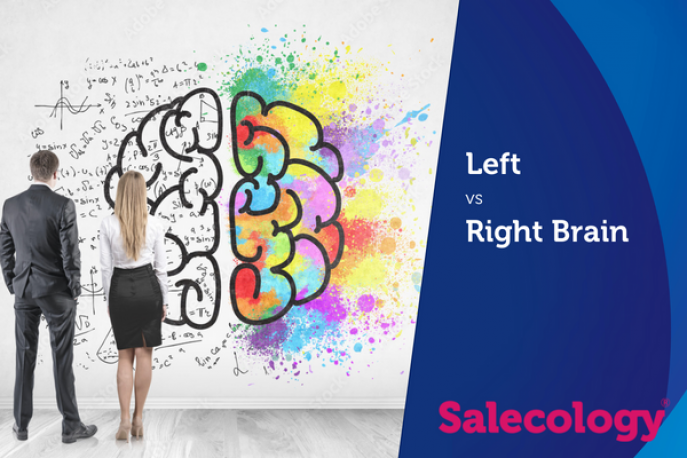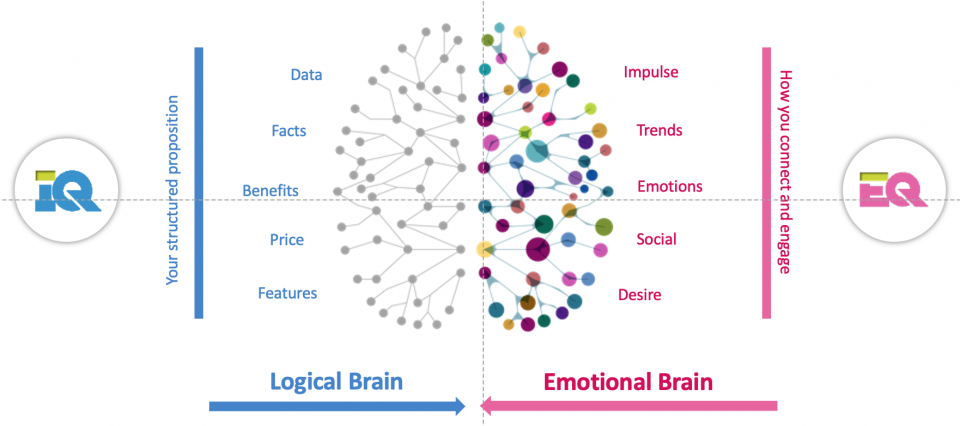
The human brain has evolved to be remarkably proficient. From our ability to form connections and tribes to our aptitude for tools and technology, we are a species defined by the never-ending stream of ideas that shape our existence. Indeed, to be human is to think, to perceive, and to think about that perception all the while. We’ve evolved the keen ability to learn time saving heuristics that contextualize the world around us, like our inclination towards the binary. This binary is something we’re taught from a young age – hot and cold, good and bad, right and wrong, and so on. It helped us as kids navigate our environment and our place within it, however this black and white dichotomy often extends past kindergarten into the far reaches of popular culture, and not always rightly so.
Case in point is the topic of today’s article, the concept of ‘Left vs. Right Brain’. We all know the story – each person has a dominant hemisphere that determines things like personality, sociability, and even predispositions towards certain learning styles and subjects. ‘Are you Left-Brained or Right-Brained?’ asks the online quiz, sandwiched between the daily horoscope and an article on mermaid sightings. The problem with how Right vs Left Brain is presented today is that A) it’s not very accurate, and B) it undermines the nuance of the human experience and relegates it to exist in one of two states. The same gripe can be made for other complex frameworks like gender and sexuality, wherein the dominant culture (in this case patriarchal and Christian structures) delegates one of two ways of being, but that’s an article for another time. The point being that binary thinking pervades popular culture in just about every place you look for it, and human physiology is no different.
To be clear, this isn’t to say the brain isn’t split into a left and right hemisphere, which includes not only the outer ‘cortex’ layer but multiple internal regions as well. In addition, scientists do see a correlation between the left hemisphere and linear thinking which aids in linguistics and math, and the right hemisphere and abstraction which aids in creative thinking and rhythm. This breakdown of hemisphere functionality was first discovered by Nobel Prize winner Roger W. Sperry, a psychobiologist back in the 1960s. It is also true that the left and right sides control different bodily functions like movement and sight, a process known as ‘lateralization’. However, problems arise when we overextend the science of lateralization to more ephemeral notions of subjective experience like personality.
The misconception began back in the mid 1800’s when two neurologists, Wernikle and Broca, examined subjects with brain damage who struggled with communication. Damage was isolated to the left temporal lobes, so the neurologists deduced that the left hemisphere was responsible for language production.
This hypothesis captured the attention of author Robert Louis Stevenson, who infamously introduced the idea of an emotional Right Brain and a logical Left Brain represented by characters in his book ‘Dr. Jekyll and Mr. Hyde’. From there, the notion that we are piloted by either our emotional Right Brain or our logical Left Brain became accepted as the norm.
Research findings from a two yearlong study at the University of Utah found that there is no evidence that indicates some people are Right-Brained or Left-Brained. "It's absolutely true that some brain functions occur in one or the other side of the brain. Language tends to be on the left, attention more on the right. But people don't tend to have a stronger left or right-sided brain network. It seems to be determined more connection by connection" said Dr. Jeff Anderson, lead author of the study. He goes on to say, “We just don't see patterns where the whole left-brain network is more connected or the whole right-brain network is more connected in some people. It may be that personality types have nothing to do with one hemisphere being more active, stronger, or more connected."
Alright, so it sounds like an open and shut case; through centuries of storytelling a relatively complex topic in neuroscience has disseminated through popular culture, while the science from which it came grew increasingly inaccurate. This trend is part and parcel of what it means to live in a globalized world where news outlets and social media channels filter and reframe information to fit a worldview, a 60 second time slot, or the dimensions of our smartphones. Are we done here? Is this where we’re ending the article? Well, no, not quite.
You see, the concept of Right vs. Left Brain is actually incredibly useful for salespeople and organizational leaders to understand, and is one of the basic principles that informs what we do here at Salecology. However, one important detail needs to change for this framework to fly under our neuroscientific approach, and that is the semantics around ‘logical’ and ‘creative’ to refer to the Left and Right Brain respectively. Instead, using the terms ‘rational’ and ‘emotional’ does away with the upheld fallacy by using psychological terminology that applies directly to sales.

If we zoom out and parse through the evolution of selling techniques over several decades, we see a clear trend in which sales have become increasingly logical and data driven: The 50’s Persuader presented the product and hard facts, which evolved into the Solutions Seller who conducted a ‘needs analysis’ and talked ‘features & benefits’; followed by the Collaborator who focused on bringing insight and demonstrating the return on investment. In all three sales schools of thought we see a strong emphasis placed on appealing to the rational consumer: the Left Brain. =
Of course you needed to be personable, but there’s a strong belief that building an airtight argument out of facts, numbers, and ROI is going to be what persuades a customer to buy.
“How could they possibly refuse this product/service after I’ve established such a sensible and thorough sales pitch? - it’s a no brainer!” And yet products/services are refused all the time. Why is that? Why do people hang up the phone on sales calls that present clear returns on investment? What other forces are at play here just under the surface?
The real drivers for why customers buy don’t exist in the logical side of the brain, but in the emotional, irrational side. It’s forces like impulsiveness, social trends, perceptions around coolness, user reviews on forums like TripAdvisor and Yelp, as well as sheer desire or ego that drive people to spend their money. It is only after the fact that consumers use logic and reasoning to justify the emotional purchase. What’s more, this emotional predisposition towards decision making is not reserved for consumer sales, it is exhibited time and time again in B2B and corporate sales. Even in tender documents where the tender criteria are described, we see informal criteria take precedent the moment bids are placed; those with closer emotional connections to the panel tend to win the contract over those without rapport. This irrational part of the brain forms part of our subconscious mind, so these impulses feel less like deliberate choices and more like ‘gut feelings’. Harvard Professor Gerald Zaltman identified that 95% of all purchase decisions are made in this unconscious part of the mind.
In an age where media literacy is rising due to the transparency social media affords us, customers are more aware than ever of advertising and sales tactics. Not only this, but the reputation of the average salesperson isn’t all that great to begin with. Savvy salespeople will need to work that much harder to rise above the stereotype and surprise patrons with their radically modernized techniques. The most successful of the bunch will employ the kind of emotionally intelligent frameworks we teach here at Salecology to their gambit, winning clients over with their deep listening skills, thoughtful questions, and a genuine interest in helping solve each problem. Moreover, they’ll need to be able to read a client’s personality in seconds and adjust their approach to align with the way that person likes to be communicated with. They will need to know how to alter their body language, tone, cadence, and directness on the spot, all while remaining authentic to their own selling style. Mastering these techniques will be what creates the kind of rapport that keeps clients coming back year over year.
Is that unique – on the face of it, no. Listening, questioning, adapting to our customer is something we have done for decades. The real difference is having a richer understanding of how the subconscious mind works, of behavioural patterns, how to spot emotional triggers, and how to unlock these forces through the use of language, nonverbal interactions, and many more subliminal influencing techniques.
Can you teach this? In short yes – but of course some people have a higher starting point than others. There are 3 key things to consider:
1: Ensure you hire people who have the innate personality traits, aptitude, and motivations
2: Build the new skills and behaviours into your sales methodologies
3: Deliver product training differently
A great example of this can be demonstrated in our new Varsity programme. Varsity is an 8-week finishing program that scouts, recruits, and trains university graduates in the art and science of sales. Using our award-winning framework, we identify those who have the right aptitude, personality, and motivations. This can’t be completed in an interview or Cv screen alone, it requires psychometrics and exercises that allow you to see the individual’s behaviour, and not simply their knowledge.
Those who are selected then undergo intensive, hands-on training to grow their confidence and teach them how to engage customers, build connections, and utilise questioning techniques that influence and engage both the emotional and rational brain. Varsity teaches delegates to learn their products and services through the lens of psychology and neuroscience, helping them receive more ‘yeses’ from their clients quicker. When compared to hiring those with experience against graduates without, Varsity has tripled the predictability of the new hires being successful in their organisation. It shortens ramp up times, flattens the learning curve, and gets the new hire to effectiveness typically in weeks rather than months – thus producing an immediate ROI for the companies that hire them and reducing churn.
When looking at your organisation, consider how your sales team develop their approach to engage the left and right brain – rational vs emotion. It is hard to pinpoint who first said it, but ‘emotion drives motion’. If the customer isn’t emotionally engaged in your proposition the deal will almost certainly lose momentum, but if they are, the deal will close itself.
